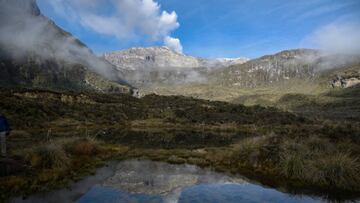Volcán nevado del Ruiz: ¿qué necesita para pasar a alerta roja y qué implicaciones tendría?
Hasta el momento se ha mantenido la alerta naranja sobre la actividad del Volcán Nevado del Ruiz. Conozca qué pasaría si llegará a la alerta roja.

Desde el 30 de marzo, el Servicio Geológico Colombiano (SGC) ha estado monitoreando la actividad del Volcán Nevado del Ruiz. Tras registros de aumento de aumento de la actividad sísmica al interior del volcán, se aumento el nivel de alerta de amarillo a naranja. Esto significa que el volcán podría tener una erupción mayor en cuestión de días o semanas. Los niveles de alerta según la entidad son los siguientes:
- Nivel I, Rojo: Erupción inminente o en curso
- Nivel II, Naranja: Erupción probable en termino de días o semanas
- Nivel III, Amarillo: Cambios en el comportamiento de la actividad volcánica
- Nivel IV, Verde: Volcán activo y comportamiento estable
Durante la semana del 3 al 8 de abril, se estuvieron realizando actividades que buscan salvaguardar la vida de las poblaciones que se encuentran en la zona de influencia del volcán. Municipios de los departamentos del Caldas, Tolima, Risaralda, Cundinamarca y Tolima se encuentran en esta zona. Para conocer el nivel de amenaza de su municipio puede consultar el mapa de amenaza realizado por el SGC.
¿ Qué hace falta para que pase a alerta roja?
Noticias relacionadas
De acuerdo con el SGC, si se determina que el volcán esta en alerta roja, significa que la erupción está en curso y es inminente. El tiempo de preparación ante un aumento de alerta es muy corto. Según la entidad, podrían tardarse entre 10 y 15 minutos para confirmar que se este presentando una erupción mayor.
El SGC ha sido enfático en mencionar que no es posible predecir como será una erupción y los efectos que tendrá. Sin embargo, se preparan las poblaciones ante la caída de cenizas, residuos sólidos y flujos o avalanchas de lodo. Por último, hacen un llamado para que los ciudadanos mantengan la calma y consulten frecuentemente las fuentes de información.
El volcán Nevado del Ruiz continúa en nivel de actividad NARANJA 🟠, pero está dentro de las probabilidades que cambie a ROJO🔴. Si esto pasa, les damos cinco datos clave para tener presentes. ⬇️ pic.twitter.com/QuhLgecJWN
— Servicio Geológico Colombiano (@sgcol) April 8, 2023

